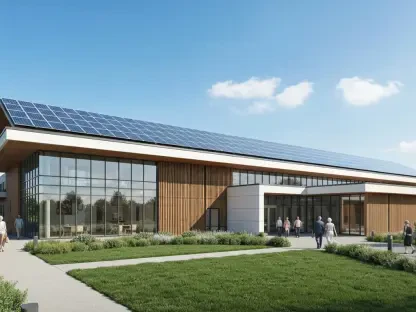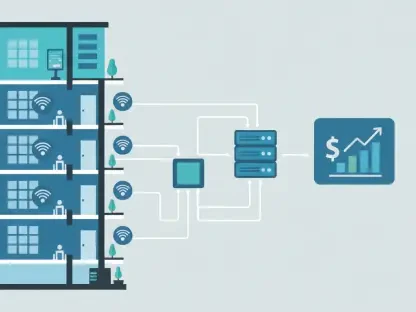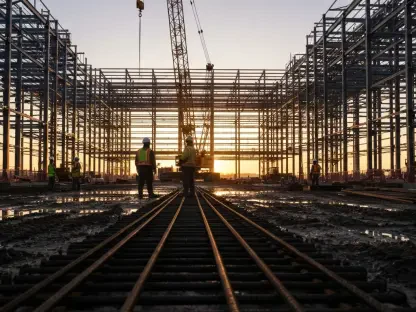As the construction industry across the United States navigates a landscape of recovery and uncertainty, recent data reveals a sector that is both robust and vulnerable to emerging economic pressures, with national payroll employment in construction reaching an impressive 8.3 million as of June this year. This figure surpasses pre-pandemic peaks by a notable 9.4%, signaling a strong rebound, with many states reporting unemployment rates lower than those seen before the health crisis. Yet, beneath this surface of progress, there are signs of caution. Economic factors such as rising material costs, high interest rates, and labor challenges are creating hesitancy among builders and developers. While layoffs remain rare, hiring has slowed, reflecting a broader wait-and-see approach. This duality of strength and concern raises critical questions about the sustainability of current employment trends in the face of potential slowdowns projected for the coming months and into next year.
National Trends and Recovery Metrics
The national picture of construction employment paints an encouraging story of recovery, with the sector demonstrating significant resilience in the wake of past economic disruptions. Payroll numbers have climbed to a historic high of 8.3 million, a clear indicator of growth that outstrips the pre-pandemic benchmark of 7.6 million by nearly 10%. Moreover, the national unemployment rate for construction workers saw a marginal decline of 0.1% from May to June, suggesting a stable labor market despite broader economic concerns. This stability is further evidenced by the fact that unemployment rates remain below 10% across all states, a positive sign of industry health. However, this recovery is not without its caveats, as external pressures like tariffs on building materials and elevated interest rates threaten to dampen momentum. Industry stakeholders are increasingly cautious, prioritizing the retention of skilled labor over aggressive hiring, which could signal a shift in strategy if economic conditions worsen in the near future.
Beyond the headline numbers, the recovery’s depth varies significantly when viewed through a historical lens, highlighting both achievements and areas of concern. Compared to June six years ago, 37 states have reported lower construction unemployment rates, showcasing a broad-based improvement across much of the country. This progress reflects a sector that has adapted to challenges and capitalized on demand for infrastructure and development projects. Yet, the pace of recovery is uneven, with some regions faring better than others. The slight month-to-month improvements in unemployment rates mask underlying anxieties about future growth, particularly as economic forecasts point to potential slowdowns later this year and into 2026. Analysts note that while the industry has built a strong foundation for employment, the looming uncertainty around cost structures and financing could erode these gains if not addressed. This tension between past success and future risk underscores the complex dynamics at play in the national construction employment landscape.
Regional Disparities in Unemployment Rates
When examining construction unemployment on a state-by-state basis, a stark contrast emerges between regions experiencing historic lows and those grappling with persistent challenges. States like South Dakota, with an unemployment rate of just 0.8%, and North Dakota at 1.2%, stand out as leaders, alongside New Hampshire, Montana, and Oklahoma, all boasting rates under 1.5%. These figures often represent the lowest June rates on record for these states, reflecting robust local economies and sustained demand for construction labor. On the flip side, states such as Rhode Island, with a rate of 8.9%, and New Jersey at 8.5%, face significantly higher unemployment, though some, like Rhode Island, have seen notable monthly declines of up to 1.9%. This geographic disparity highlights how localized economic conditions, project pipelines, and workforce availability shape employment outcomes, creating a patchwork of recovery across the nation that defies a uniform narrative.
Further analysis of month-to-month trends reveals additional layers of complexity in the regional employment picture, with fluctuations signaling both progress and caution. From May to June, 29 states experienced declines in construction unemployment rates, a promising sign of continued improvement in many areas. However, 19 states saw increases during the same period, while two remained unchanged, pointing to uneven momentum. States like South Dakota and Montana have also shown impressive year-over-year drops of 1.7% and 1.5%, respectively, reinforcing their status as recovery frontrunners. Conversely, higher rates in states like Connecticut at 5.2% and New Mexico at 4.8% underscore ongoing struggles, even as some of these regions show historical improvement. These variations suggest that while the overall sector remains strong, regional economic factors and policy environments play a critical role in determining employment health, raising questions about how targeted interventions might address disparities in the months ahead.
Economic Challenges on the Horizon
Despite the construction sector’s notable recovery, several economic headwinds are casting shadows over future employment stability, prompting a more guarded outlook among industry leaders. Rising material costs, driven in part by tariffs, have already strained budgets, with uncertainty about the duration or potential escalation of these trade policies adding to the unease. High interest rates are another hurdle, complicating project financing and deterring new developments, particularly in regions already facing economic softness. Additionally, escalating labor costs continue to challenge profitability, even as employers remain reluctant to reduce headcounts. This reluctance reflects a strategic focus on retaining skilled workers amid fears of future shortages, but it also limits flexibility to adapt to changing conditions. As a result, the industry finds itself at a crossroads, balancing current strength against the risk of slowdowns projected for late this year and beyond.
Looking deeper into these challenges, the interplay of external pressures reveals a sector navigating a precarious path, where short-term stability could give way to longer-term constraints. Industry experts, including economic advisors, have noted a growing hesitancy among builders and developers to commit to new projects, a trend that could stifle hiring if economic conditions deteriorate. The lack of clarity around tariff adjustments exacerbates planning difficulties, as firms struggle to predict cost trajectories. Meanwhile, high interest rates not only impact borrowing but also dampen investor confidence, particularly for large-scale infrastructure or residential projects. While layoffs are currently uncommon, the slowdown in hiring suggests a wait-and-see approach that could become more pronounced if forecasts of economic softening materialize. Addressing these issues will likely require coordinated efforts between policymakers and industry stakeholders to mitigate cost pressures and support sustained employment growth in the face of uncertainty.
Reflecting on Industry Resilience
Looking back, the construction sector demonstrated remarkable fortitude in overcoming past economic disruptions, with payroll employment surpassing pre-pandemic levels and many states achieving historically low unemployment rates by June. The national landscape reflected a workforce that adapted to adversity, driven by demand for critical projects and infrastructure development. Regional disparities painted a varied picture, yet even states with higher rates showed signs of progress over time. Economic challenges like tariffs and interest rates loomed large, but the reluctance to shed skilled labor underscored a commitment to long-term stability. Moving forward, the industry must focus on innovative cost management, advocate for favorable trade policies, and explore financing solutions to weather potential downturns. By building on past resilience and addressing emerging risks proactively, the sector can aim to sustain its workforce and maintain momentum in an uncertain economic climate.









